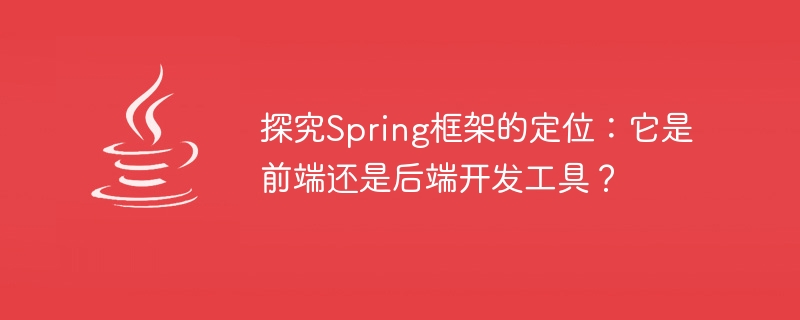

Explore the positioning of the Spring framework: Is it a front-end or back-end development tool?
Introduction:
Spring is a powerful and widely used open source framework for Java enterprise application development. However, for beginners, the positioning of the Spring Framework may feel a bit vague. Is it a front-end or back-end development tool? This article will explore the positioning of the Spring framework and give relevant code examples.
1. Overview of the Spring Framework
Spring is a container framework for IoC (Inversion of Control) and AOP (Aspect-Oriented Programming). Its goal is to simplify the development of enterprise-level Java applications, provide a lightweight programming model, and is scalable and flexible.
As an IoC container, Spring provides a decoupling method, and the dependencies between various objects are managed by the Spring container. By using Dependency Injection (DI), objects can obtain other dependent objects through constructors, setter methods or field injection, thereby achieving loose coupling. This provides developers with greater flexibility and testability.
As an AOP framework, Spring can modularize cross-cutting concerns (Cross-Cutting Concerns) and separate them from core business logic. In Spring, you can achieve code reuse across cutting concerns by defining aspects and advices.
2. Application of Spring Framework in Front-end Development
Although Spring is mainly used for Java back-end development, it also has certain application scenarios in front-end development.
In an architecture where the front and back ends are separated, the front end interacts with the back end through the RESTful interface. The Spring framework provides Spring MVC, a module that supports RESTful architecture. By using Spring MVC, we can easily create RESTful web services and perform unified request distribution and exception handling on them. The following is a simple RESTful interface example:
@RestController
@RequestMapping("/api")
public class UserController {
@Autowired
private UserService userService;
@GetMapping("/users")
public List<User> getAllUsers() {
return userService.getAllUsers();
}
@PostMapping("/users")
public void createUser(@RequestBody User user) {
userService.createUser(user);
}
// 其它接口...
}In front-end development, sometimes it is necessary to generate dynamic HTML on the back-end and pass it to Display on the front end. Spring provides a view resolver (ViewResolver) to support front-end rendering engines, such as Thymeleaf. The following is a simplified Thymeleaf view parser configuration example:
@Configuration
public class ThymeleafConfig implements WebMvcConfigurer {
@Bean
public ViewResolver viewResolver() {
ThymeleafViewResolver resolver = new ThymeleafViewResolver();
resolver.setTemplateEngine(templateEngine());
return resolver;
}
@Bean
public SpringTemplateEngine templateEngine() {
SpringTemplateEngine engine = new SpringTemplateEngine();
engine.setTemplateResolver(templateResolver());
return engine;
}
private ITemplateResolver templateResolver() {
ServletContextTemplateResolver resolver = new ServletContextTemplateResolver();
resolver.setPrefix("/WEB-INF/templates/");
resolver.setSuffix(".html");
resolver.setTemplateMode("HTML5");
return resolver;
}
}3. Application of Spring framework in back-end development
Although the Spring framework has certain applications in front-end development, it The main positioning is still in back-end development.
Spring provides a series of modules, such as Spring Boot, Spring Data, Spring Security, etc., which can be used to implement complex business logic. By using them, we can develop high-quality backend applications more efficiently. The following is an example of using Spring Boot to build a RESTful web service:
@SpringBootApplication
public class Application {
public static void main(String[] args) {
SpringApplication.run(Application.class, args);
}
}The Spring framework provides a variety of data access modules, such as Spring JDBC , Spring ORM (such as Hibernate, MyBatis), Spring Data JPA, etc. They can help us implement database access and transaction management functions. The following is an example of using Spring Data JPA to access the database:
@Repository
public interface UserRepository extends JpaRepository<User, Long> {
Optional<User> findByName(String name);
// 其它查询方法...
}
@Service
@Transactional
public class UserService {
@Autowired
private UserRepository userRepository;
public User createUser(User user) {
return userRepository.save(user);
}
// 其它业务方法...
}Conclusion:
In summary, the Spring framework can be applied in both front-end and back-end development . It is primarily positioned as a back-end development tool, but still provides some useful features in front-end development. According to specific project needs, rational use of various modules of the Spring framework can allow us to develop high-quality applications more efficiently.
The above is the detailed content of Role definition of Spring framework: Is it a common tool for front-end or back-end development engineers?. For more information, please follow other related articles on the PHP Chinese website!




